Operation Anaconda
After squeezing the militants of the Taliban movement and the Al Qaeda terrorist group from Kabul and the fortified Tora Bora cave complex in November — December 2001, some of the militants retreated to the Gardez area in southeast Afghanistan. The experience of carrying out the operation in Tora Bora clearly demonstrated that with massive air strikes alone it is impossible to destroy an enemy who has taken refuge in numerous extended mountain caves. At the beginning of 2002, the American command received intelligence that the militants were regrouping in the Shahi-Kot valley. Anticipating the actions of the Islamists, the Americans decided to conduct an air-ground operation. However, the strength and determination of the enemy to fight were not adequately evaluated. Due to the fact that the forces of the Taliban, opposing the international antiterrorist coalition, had avoided direct and prolonged clashes, the US command had a "dizzy with success."
Preparation for Operation Anaconda began in early February 2002. In the course of its conduct, it was planned to land helicopter assault forces at eight key locations in the valley, cut all escape routes, and then destroy the enemy with air strikes. Shahi-Kot Valley is located in a remote mountainous region in Paktika province, between the cities of Khost and Gardez. With a length of about 8 km and a width of about 4 km, it is located at an altitude of 2200 m and is surrounded from the west by mountains higher than 2,7 km, in the east the height of the mountains reaches 3,3 km. There are many karst and man-made caves and narrow crevices in the valley. Only two roads lead to the valley, and both of them can be blocked by small forces. Thus, the Taliban were supposed to be "between the hammer and the anvil."
The operation was scheduled for the end of February, but due to bad weather conditions that hinder actions aviation, its beginning was shifted to March 2. The plan provided for a fairly simple scenario of actions. American-friendly armed formations of the Northern Alliance (more than 1000 Afghans) were to enter the valley, and three American battalions (1200 men) and special forces from the USA, Australia, Germany, Denmark, Canada, Norway and France (several hundred men) would block all exits from it, which would ensure the environment of the enemy. The command of the US armed forces in Afghanistan, which did not have reliable data on the enemy’s forces, was counting on an easy victory, in reality, al-Qaeda militants, who in this area were much more than they seemed, were ready for defense and were determined to fight . It was believed that in this area there are from 200 to 300 militants, armed mainly with light infantry weapons, in fact, they turned out to be more than 1000. By and large, the operation "Anaconda" was originally planned as a police event to "clean up" the valley and the four surrounding villages: Marzarak, Babulkel, Serkhankel and Zerki Kale.
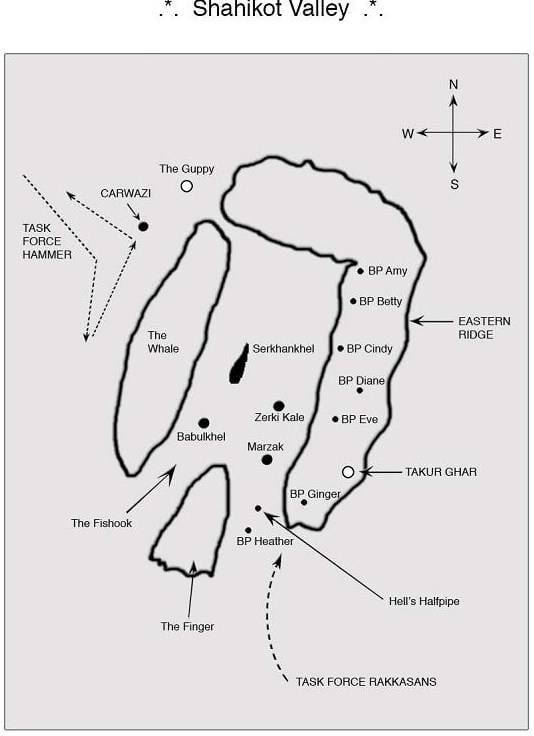
According to the idea of the generals, the mountains and the ridges around the valley were to block the combat groups of the 3 th brigade of the 101 th airborne division of the US Army and the 1 th battalion of the 87 th regiment of the 10 th mountain division, which formed the Sickle target groups during the operation. And the Anvil. The Northern Alliance Afghans and special forces, divided into small units, were united into the Molot tactical group. They had to scour the area and villages immediately after blocking the valley. Air support was provided by airplanes and helicopters of the US Air Force and French fighter-bombers. In addition to the American special forces, operatives from Australia, Great Britain, Germany, Denmark, Canada, Norway and New Zealand were included in the units belonging to the Molot group.
1 March 2002 Special Forces Group with the callsigns “Juliet”, “India”, “Mako 31” and their supporting American and Canadian sniper pairs moved out of the Gardez area in order to take positions at the exits from the valley. At the same time they were able to quietly eliminate the observers on the hill, controlling the approaches and the enemy calculation with the 12,7-mm DShK machine gun. The groups "Juliet" and "India" were mainly composed of soldiers "Delta". The Mako 31 group, which consisted of the DEVGRU naval special forces, was tasked with creating an observation post on high ground, from where the landing zone of the Anvil landing group was viewed.
Close to midnight, the forces of the “Hammer” group began to pull up to the area on off-road vehicles. It was impossible to drive up imperceptibly, because of a bad road and a threat to fall into the abyss, it was decided to turn on the headlights, thereby unmasking itself. Thus, the element of surprise was lost. As they moved from the main forces, small groups were separated, which occupied positions at higher elevations and convenient points for observing and controlling the terrain. One of these groups, which did not identify itself on the ground as friendly forces, was incorrectly identified by the operators of the AC-130Н patrolling in the air, adopted as a suitable reinforcement by the Taliban and fired from onboard guns. As a result, the warrant officer Special Forces Stanley Harriman died as 12 Afghans and 1 special forces were injured of varying degrees of severity.

The main part of the tactical group "Hammer" reached its position by 5.30 in the morning and stood in anticipation of an air raid on the mountain range, where, as expected, the enemy forces were hiding. The active phase of the operation began in the early morning of March 2, when a large-caliber aerial bomb was dropped on the mountains by an American bomber.
From the very beginning of the operation, everything did not go as planned by the American strategists. The result of the bombing was exactly the opposite of what the Americans expected. Instead of running in panic and hiding, the Taliban drove several pickups with ZNU's 14,5-mm units, mortars and no-recoveries, and began bombarding the machines of the Molot group that had accumulated in a small space in front of the valley entrance. As a result of the shelling around 40, the special forces and the Afghans accompanying them were killed or injured. An attempt by the special forces to advance deep into the valley was met with fierce resistance from small arms, heavy machine guns and 82-mm mortars. At that moment, it finally became clear that the surprise attack would not work and the defense of the Taliban was well prepared. The Afghan forces of the Northern Alliance, attached to the special forces, after the start of the battle, hurriedly retreated to the village of Karvazi, located outside the combat zone.
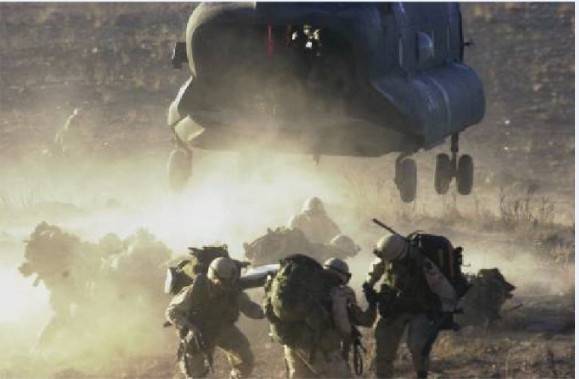
At that moment, the American Chinook X-NUMX transport helicopters launched the landing of the 47 airborne and 101 mountain divisions (a total of 10 people) on the eastern and northern edge of the valley to prevent the Taliban from escaping. Almost immediately after the landing, on the way to their blocking positions, the soldiers of the 200 division landed from helicopters got into a “fire bag”. On paratroopers from three sides fired from small arms from machine guns to large-caliber machine guns of caliber 10-mm, 14,5-mm mortars also took part in the shelling. Due to the fact that the second wave of the assault was canceled, at the disposal of the Charlie company of heavy weapons there was only one 82-mm mortar with limited ammunition. As a result, the mountain arrows of the Charlie company (120 man) of the 86 battalion of the 1 regiment of the 87 division lay down behind improvised shelters at the southern entrance to the valley and spent a fierce firefight all day. During the battle 10 US military personnel were injured of varying severity. The actions of aviation, which were corrected by Australian SAS officer Martin Wallace, who was in the company’s combat formations, saved them from the final extermination. In addition to the mountain shooters of the 28 Division, air support was repeatedly requested by other groups that took positions on the slopes adjacent to the valley.
Sniper couples with large-caliber rifles, who took up positions on the heights, rendered great help to the defenders. They repeatedly managed to destroy the fire spotters, machine-gunners and mortar calculations at the maximum shooting distance. During the battle, successful hits were recorded at a distance of 2300 and 2400 meters.
Aircraft support for American soldiers stuck in the mountains of Afghanistan was provided by airplanes: B-1В, B-52Н, F-15E, F-16C. On the first day of Operation Anaconda, aviation dropped more than 80 tons of bombs in the Shahi-Kot valley, including a volume explosion weighing 907 kg. But the most significant support was rendered by five AN-64A Apache helicopters of the 101-th aviation battalion of the 159-th aviation brigade. In the daytime, the tasks of the direct aviation support were assigned to the combat helicopters, at night - the actions of the ground forces supported the AC-130Н. Ganships were not used during daylight due to the threat of destruction of MANPADS. At that time in Afghanistan at the disposal of the American contingent there were only seven combat helicopters AN-64A "Apache". During the battle, patrolling along the valley, the Apache crews acted at the request of ground forces or searched for targets on their own, using the entire range of weapons available: the Hellfire ATGM, 70-mm unguided missiles and 30-mm guns. Thanks to the actions of the combat helicopters, the soldiers of the 101 airborne division were able to equip positions for 81-mm mortars, which seriously strengthened their defenses and helped to further repel the attacks of the Taliban.
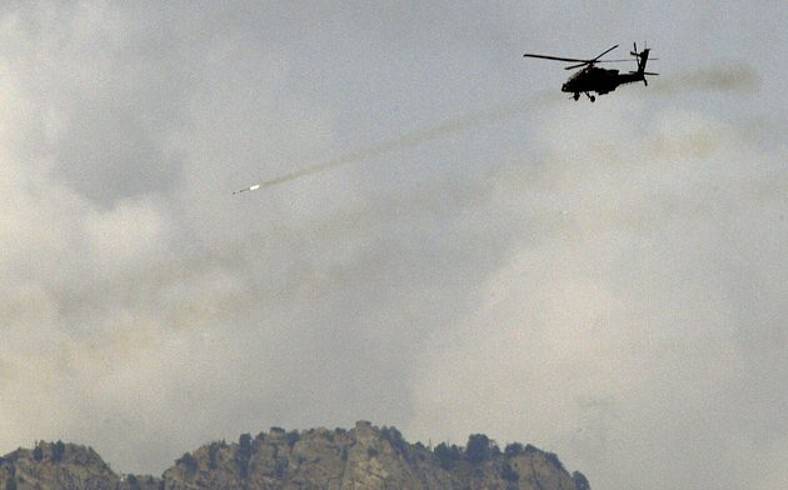
During combat missions on the first day of operation "Apache" received multiple combat damage. The first attack helicopter dropped out of the game shortly after the start of the active phase of the operation. In 6 h 45 mines near AN-64A senior warrant officer Jim Hardy a grenade exploded from an RPG. In this case, the splinters damaged the sight and sight system and the gun. After a few minutes of damage received a second helicopter. The Apache's commander, senior warrant officer Kate Harley, was wounded by a bullet piercing the cockpit armored glass, and the captain Bill Ryan, the commander of an aviation company, was also slightly wounded. After the battle, 13 bullet holes from 12,7-caliber bullets were counted in the helicopter. On the dashboard in the cockpit lit alarm system oil system. Both combat helicopters left the battlefield, taking a course at the forward refueling and supply point located in Kandahar. The helicopter Harley was able to fly just a mile and a half, after which, due to the threat of an uncontrolled fall, he went for an emergency landing. As it turned out, the oil and most of the hydraulic fluid had completely leaked from the helicopter. The crew after landing, despite injuries, managed to safely leave the shelling zone. Pilot Jim Hardy decided to continue the flight on a damaged car, having spent 26 minutes in the air, despite the fact that the Boeing company guarantees the operation of helicopter systems without oil for 30 minutes. In a short period of time, the Americans lost three helicopters due to the strongest anti-aircraft fire. Almost at the same time as the Apaches, the Black Hawk UH-60 helicopter, which was carrying the landing force colonel Frank Wichinski, was damaged. RPG grenade exploded under the fuselage of the helicopter, after which the pilot made an emergency landing.
On this day, all seven Apaches had combat damage of varying severity. During the battle of 2 in March, combat helicopters surpassed all other types of aircraft that had provided air support to ground units in terms of their effectiveness against the enemy.
Soldiers of the “Hammer” and “Anvil” groups fixed on the slopes of the mountains and at the entrances to the valley, as well as sniper couples and observers spent a very “cheerful” night, during which they had to shoot from the militants. If it were not for the ganships constantly hanging in the air, a considerable part of the Americans could not survive this night.
Already on the first day of the operation, when intelligence miscalculations became apparent, the number of the landing forces had to be increased by attracting additional units. The helicopters deployed an additional several hundred soldiers and officers. Only the next day in the northern part of the valley, where the fire was not so strong, could a second wave of assault forces with a population of 200 manage to land. In addition to small arms, they had several 81 and 120-mm mortars.
A-10A, AC-130Н, B-1В, B-52Н, F-15E, F-16С, F-14D, F / A-18С, Mirage 2000DS aircraft provided aviation support to ground forces. In this operation, the F-14D heavy deck-based fighters ending their combat career struck the GBU-38 JDAM bombs at previously reconnoitered targets. French Mirage 2000DS fighter-bombers operated from the Manas airbase located on the territory of Kyrgyzstan.
However, despite the landing of additional forces and the unwinding flywheel of air strikes, the enemy did not demonstrate any intention to retreat. In this regard, it was decided to land additional special forces at the dominant heights. On the night of March 3, on two CH-47 160 th aviation regiment of the United States Army, an attempt was made to deliver a special forces group to the highest point in the area dominating the terrain - Mount Takur-Gar, where a survey covered the entire valley 15 km around. The pilots flew helicopters with night vision goggles.
On board the helicopters were fighters of special forces SEAL BMC USA. The reconnaissance of the area was carried out by the thermal imaging equipment of the aircraft АС-130Н, which did not reveal any signs of the presence of the enemy in the area. As it turned out later, not far from the top of the mountain, among the large rock debris, several shelters were equipped, covered with stone chips on top. Because of the rush (they wanted to have time to transfer them there before dawn), the operation to deliver the group began almost without preparation, although the officer commanding the landing party requested a postponement. Initially, it was assumed that the landing force would land 1300 meters east of the summit and get to the summit on foot, but due to time constraints and engine problems in one of the helicopters, they decided to land on the summit itself.
Hanging over the top, the helicopter pilots reported that they saw human tracks and other signs of recent activity on the snow and asked the command for further action. At that moment the helicopters got into a well-organized ambush. One Chinook got hit by an RPG grenade, as a result of which the hydraulic system was damaged on a helicopter. During the shelling of the open ramp, the head of the first article, Neil Roberts, fell out. After it turned out, Roberts survived the fall, and he even managed to turn on the rescue beacon, but later, according to the official version, he was discovered by the Taliban and died. The crew of the damaged helicopter managed to fly a kilometer from the ambush site and landed in the valley, 4 km below the mountain. After inspecting the damage, it was decided to destroy the wrecked helicopter. Located on the approach of the second Chinook, who had already received a message about the shelling and the fall of Roberts, made a circle over the alleged location of the special forces, but also came under heavy shelling. The aircraft carrier Sergeant John Chapman was killed, two soldiers on board were injured, and the helicopter was damaged. Under these conditions, the command issued an order to depart and caused an AC-130H aircraft, which struck its artillery at the location of the militants. However, it is not clear what prevented the advance of “combing” the landing site with fire.
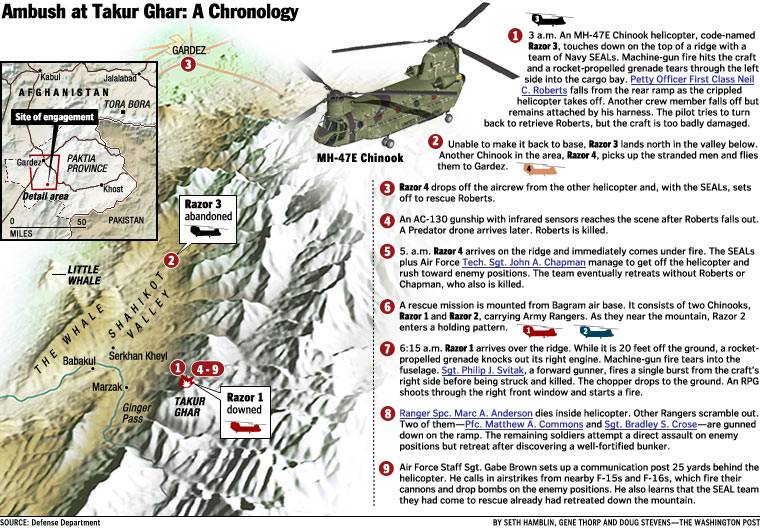
To search and rescue Roberts on 3.45, an immediate response unit of the rangers unit stationed at Bagram airbase was raised in alarm. From the Bagram airbase on two MH-47E helicopters, an 22 commando flew to the special operation area. Around this time, the command decided to change the frequencies for satellite radio communications, which some units that participated in the operation were not notified of, which later led to unjustified losses. The search-and-rescue service fighters who left the Bagram airbase believed that the fur seals were still at the top of Takur Gard and headed there because of communication problems. Upon arrival in the morning at 6.15, they came under heavy fire. The lead helicopter came under fire from the RPG-7, DShK machine guns and assault rifles. The right engine was destroyed as a result of a rocket-propelled grenade and the helicopter crashed from a small height to the top, not far from the enemy’s firing positions.
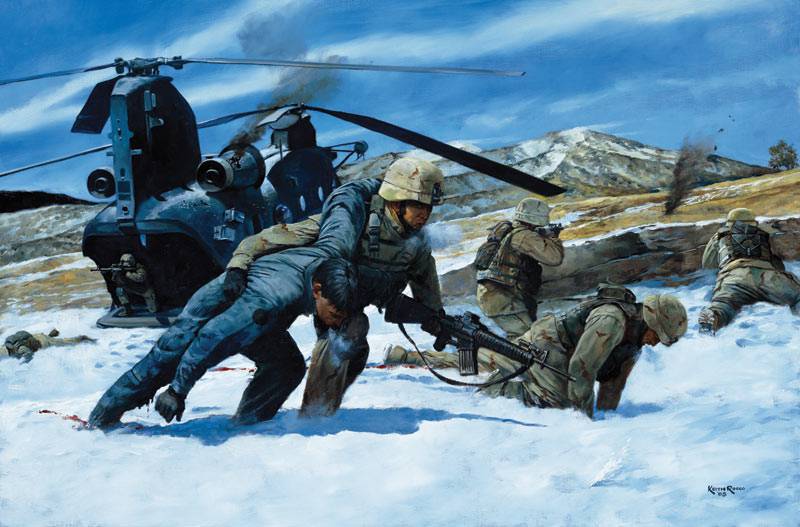
Sergeant Philip Svitak was killed while in the air by machine gun fire, and both pilots were injured. As a result of the fall of the helicopter, Matt Commons, a private first class soldier, was killed, and Corporal Brad Kroes and specialist Mark Anderson, who jumped out of the helicopter, came under fire from the enemy and were killed. The surviving Rangers took refuge where they could, and engaged in a firefight with the Taliban. The second Chinook managed to avoid serious damage and landed at Gardez.
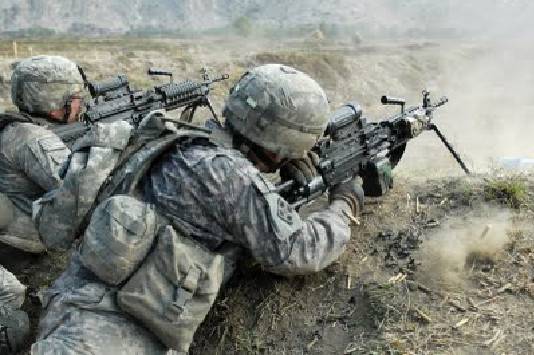
The fighters who survived the fall of the helicopter and entrenched at the top, there is a critical situation. The enemy made more and more new attempts to kill or capture the Americans. Regardless of the losses, fanatically-minded Taliban again and again rose to the attacks. It was possible to beat them only thanks to aviation support. At noon, 4 March, during a counterattack, which aimed to capture the highest point of the mountain, was fatally injured by rescuer Jason Cunningham, many soldiers were injured, but their evacuation was impossible due to the fear that any helicopter that reached the top would be shot down. Soon Australian special forces, who had been in the area since the very beginning of the operation, broke through to the defenders. The exact fire of snipers from the Mako 31 group and the organization of unprecedented aviation support helped to avoid complete physical destruction of the top-ranked Rangers. The complexity of the situation was also in the fact that the positions of the defenders were in close proximity to the positions of the Taliban who attacked them, which did not allow aviation to use powerful means of destruction. While repelling one of the attacks, the F-15E fighter-bomber pilot had to fire 20-mm cannon at the Taliban attacking the position of American special forces to complete the exhaustion of ammunition, which was not the case in the US Air Force since Vietnam.
The need to rescue American and allied forces blocked at Takur-Gar and the inability to change the situation in their favor by other methods made the command of American forces in Afghanistan to attract additional aviation forces to the operation. Including the United States Air Forces aviation was engaged from a helicopter carrier cruising near the coast of Oman. AH-1W attack helicopters, SN-53E heavy transport helicopters and AV-8B heavy vertical helicopters from the 13-th Marine Corps Expeditionary detachment were urgently prepared for combat sortie.
Five AH-1W and three CH-53Е appeared in the Shahi-Kot area on the morning of March 4. From 4 to 26 in March, AH-1W helicopters made 217 combat missions. It was spent 28 ATGM "TOU", 42 ATGM "Hellfire", 450 NAR caliber 70-mm and about 9300 shells to 20-mm guns. CH-53E transport helicopters were used to deliver cargo to the amphibious unit and provided refueling of other helicopters. The positions of mortars and enemy heavy machine guns were destroyed by powerful bomb strikes. So, during the operation, only AV-8B dropped 32 laser-guided adjustable GBU-12 bombs.
Thanks to the actions of military helicopters, the top of Mount Takur-Gar was cleared of militants, after which the rangers who defended it were evacuated. Only by 12 March, after a massive bombardment, joint American and Afghan forces managed to force the enemy out of the valley, although some skirmishes in the area continued until March 18. A total of 8 US troops were killed and 82 injured. Data on downed American helicopters are contradictory.
It is known that the Americans are trying their best to reduce their own losses. However, based on the known information, it can be concluded that as a result of the battle, at least two heavy helicopters were destroyed, one MH-47 and CH-47, one more CH-47 received heavy damage. Also one UH-60 and several AN-64А were seriously injured. One MN-47E helicopter damaged during the Anaconda operation after the end of the fighting in the area was evacuated from the emergency landing site of the Russian Mi-26 helicopter and in early April 2002 was flown to Fort Campbell.

Losses of the opponent are also authentically unknown. The total number of Taliban in the area as of 2 in March is estimated to be more than 1000 people. The American command declared that during the operation they managed to destroy about half of the militants, which, however, was not confirmed by anything. It is known that about 30 dead Taliban were found on the top of Mount Takur-Gar, many bodies were torn into fragments as a result of the impact of aviation ammunition.
It can be said with confidence that the united forces of the "anti-terrorist coalition" failed to achieve other successes, except for the expulsion of the militants from the Shakhi-Kot valley. Considering this a victory is only a stretch, especially since this “victory” came at a very high price. Many Taliban and al-Qaeda leaders hiding in caves near Shahi Kot managed to escape. This was confirmed by the interception of a convoy consisting of three off-road vehicles. The convoy was discovered drone MQ-1 Predator, after which a capture group consisting of SEALs and Rangers headed towards it on two MH-60Gs and three MH-47Es. After the lead Chinook landed in the path of the convoy, armed men jumped out of the vehicles and opened fire with automatic weapons. After a brief gunfight, during which the vehicles and the bad guys were blasted with Minigun helicopters and fired upon with small arms, resistance ceased. American special forces approaching the convoy found 16 lifeless bodies and 2 wounded at the battlefield. During the investigation, it turned out that Al-Qaeda mid-level commanders were moving in cars. Among those following in the convoy, in addition to the Afghans and Pakistanis, there were Uzbeks, Chechens and Arabs. Based on the testimonies given later by the captured wounded militants, it followed that they fled from the Shakhi-Kot area after the start of the operation.
After the completion of Operation Anaconda, the American military leadership made the appropriate conclusions. Much attention was paid to improving the coordination of joint actions between different types of troops and communication between them. And most importantly, all subsequent operations of this kind were sanctioned only after a thorough study of the intelligence obtained from different, independent of each other sources.
Based on:
http://www.airwar.ru/history/locwar/afgan/anakonda/anakonda.html
http://www.military.com/ContentFiles/FC_overview_032202.htm
http://www.seongbae.com/wp-content/uploads/2015/07/Operation-Anaconda.pdf
http://users.livejournal.com/-zmei/181207.html

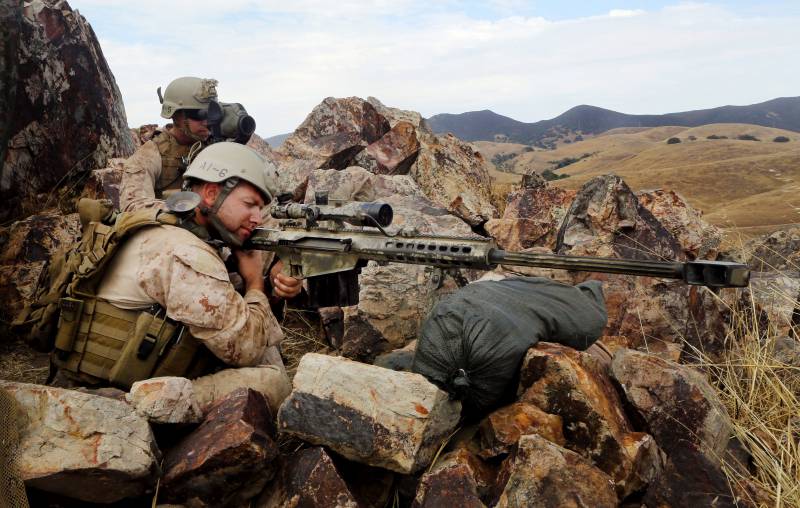
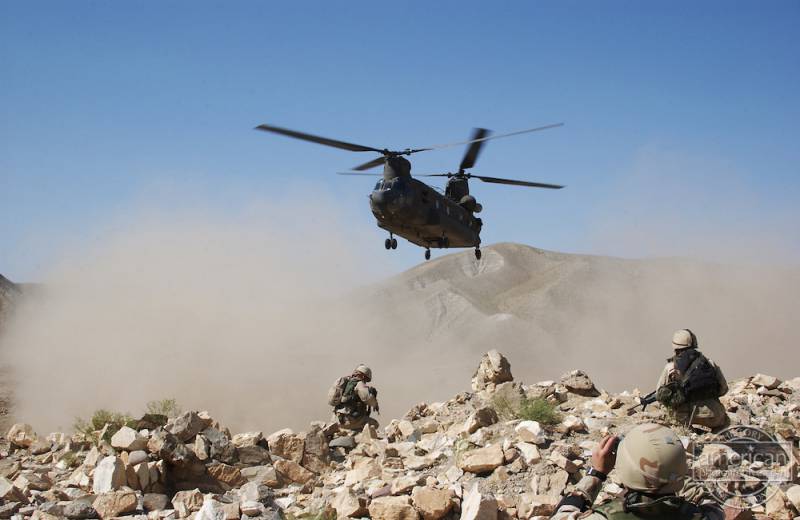
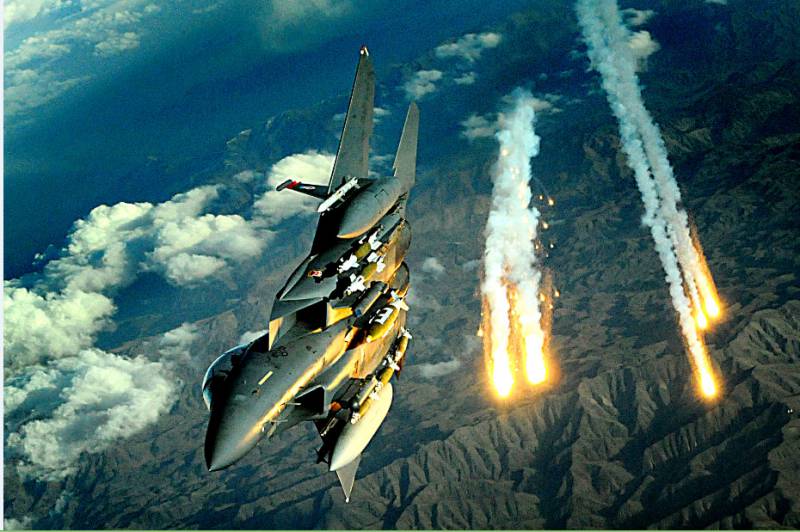
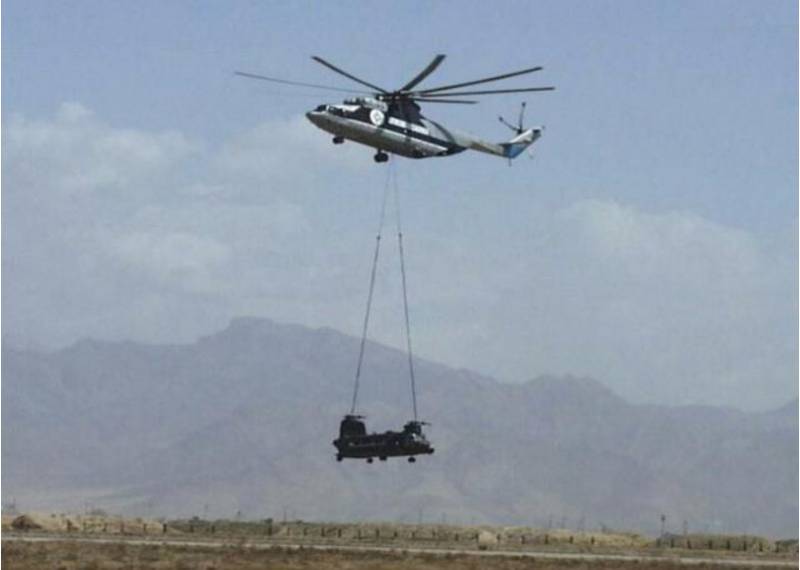
Information